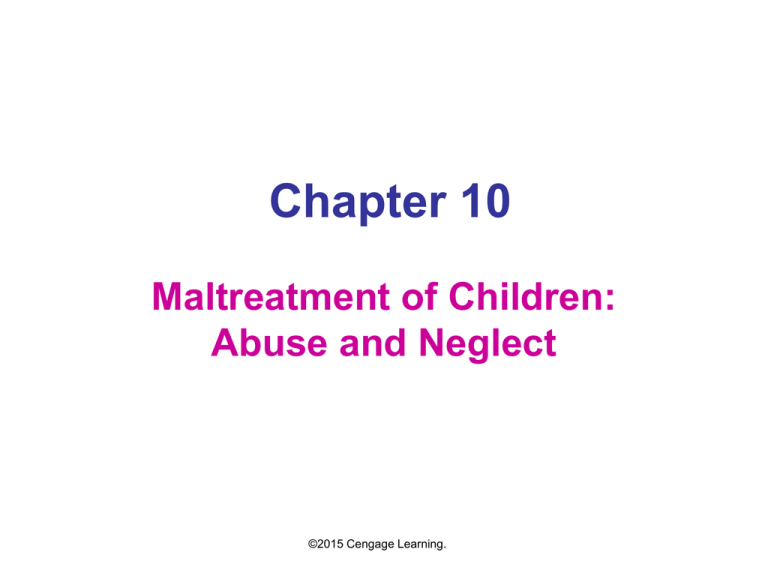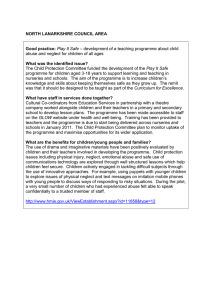
Chapter 10
Maltreatment of Children:
Abuse and Neglect
©2015 Cengage Learning.
Facts Concerning Childhood
Maltreatment
• 5 children die every day from child abuse
– 50% are children under 5 years
• Approximately 600,000 confirmed cases of child
maltreatment occurred in the U.S. (2011).
• The actual incidence of maltreatment is
estimated to be three times
greater than reported.
Facts Concerning Childhood
Maltreatment
•6 cases of abuse every minute to investigate
•Witnessing/experiencing violence affects children's brain
development.
•Brain wires itself for survival instead of learning
•Long term abuse:
-difficulty w/attention
- recall
- forming positive social relationships
- understanding emotions
-changes in DNA will increase risk for illness/chronic disease
What Happens to Children Who
are Victimized?
• Approximately 230,000 children are placed in foster care
each year.
• Victimized children are more likely to:
- engage in drug abuse
-
engage in juvenile crime
become pregnant
experience depression and other mental health disorders
commit suicide as they grow up
• They are at greater risk for:
- performing poorly in school
- repeating at least one grade
- requiring special education services
Definition of Maltreatment
• Any situation in which a child(individual under18 years)
is not safe in his/her environment because
of:
– Injury inflicted by caretakers
– Exposure to hazardous conditions resulting
from inadequate protection
– Exploitation(child labor, sexual gratification, pornography)
– Withholding medical treatment
The Challenge
• Moral and ethical dilemmas
– A families' rights versus the law
– Discipline vs. Punishment
– At what point does discipline turn into
punishment & punishment into abuse?
– Abusive treatment is often a continuum:
discipline
abuse
Is Child Maltreatment A New or
Contemporary Problem?
Historical overview:
– Children have always been abused
– “Battered child syndrome” 1961 Dr. Kempe
– 1974 Child Abuse Prevention and Treatment Act
(CAPTA)
– 1996: reauthorization included withholding medical
treatment in life threatening situations.
– 2003: reauthorization included adoption, foster care,
abandoned infants, family violence prevention
Categories of Abuse and Neglect
• Abuse
– Physical
• Shaken Baby Syndrome
– Sexual
– Emotional or Verbal
• Neglect
– Physical
– Emotional
Categories of Abuse and Neglect
• Physical abuse – unexplained physical
injuries (cuts, burns, welts, fractures,scratches,missing
hair); child may appear frightened,aggressive,
withdrawn or apprehensive.
• Sexual abuse – any sexual act performed for
adult pleasure, including inappropriate
touching, physical contact or indecent
exposure; child may have excessive curiosity
or advanced sexual knowledge (for age).
Categories of Abuse and Neglect
• Emotional or verbal abuse – excessive and
repeated name-calling, belittling, or other
negative remarks; child may appear anxious,
have persistent fears, sleep disturbances, and
behavior problems.
• Physical neglect – failure to meet child’s basic
needs and protection from harm; child may
comment about absent caregiver.
• Latch-key children- school aged children who
care for themselves before/after school.
Categories of Abuse and Neglect
• Emotional/psychological neglect – lack of
interest or responsiveness to child’s
psychological needs and development; child
may appear afraid and distrustful.
• Failure to thrive- growth & mental development
of an infant is severely slowed.
• No kissing, touching, eye contact, conversation,
facial expressions= developmental delays &
stunted growth.
Hardest to detect
Dynamics of Maltreatment
Adult predisposition vulnerable child
stress = maltreatment
• Abuse comes from all levels of socail,
economic, educational,ethic,religious,
occupational background
• Turn to page 276-277
Characteristics of Adult Perpetrators
• Most cases involve someone the
child knows and trusts.
• 4 out of 5 victims are abused by
at least one parent, more
often the mother.
• May also be other family members
or a relative, babysitter, or
neighbor.
Adult Perpetrators
• Often experience acute or chronic environmental
stress:
– Poverty, relationship problems, unemployment
– Live in social isolation and lack outside support
• Lack knowledge about children’s development
and raising children
• Use or abuse alcohol and/or other substances.
Vulnerable Children
• No group of children is immune to abuse/neglect
• Boys and girls experience maltreatment in
almost equal numbers
– Girls 4x more likely to be sexually abused
• Children under 3-4 yrs. are the
most vulnerable. Why?
• Children who have disabilities are
at high risk.
How Do You Know If A Child Is
Being Maltreated?
• A combination of behavioral and physical
indicators are typically present.
• Maltreatment is often a
behavioral pattern.
Who Is Required to Report?
• Mandated reporters:
– Teachers and early childhood personnel
– Medical professionals
– Social workers
– Law enforcement
– Any person with reason to suspect a child has
been injured by physical, emotional or sexual
abuse or neglect
Goal: Prevention and Support
• Provide quality care and education in a familyfocused program.
• Develop reciprocal relationships
with families.
• Recognize risks and signs of
abuse/neglect.
• Build on child and family strengths.
• Be informed about professional responsibilities.
• Help children develop resilience skills.


